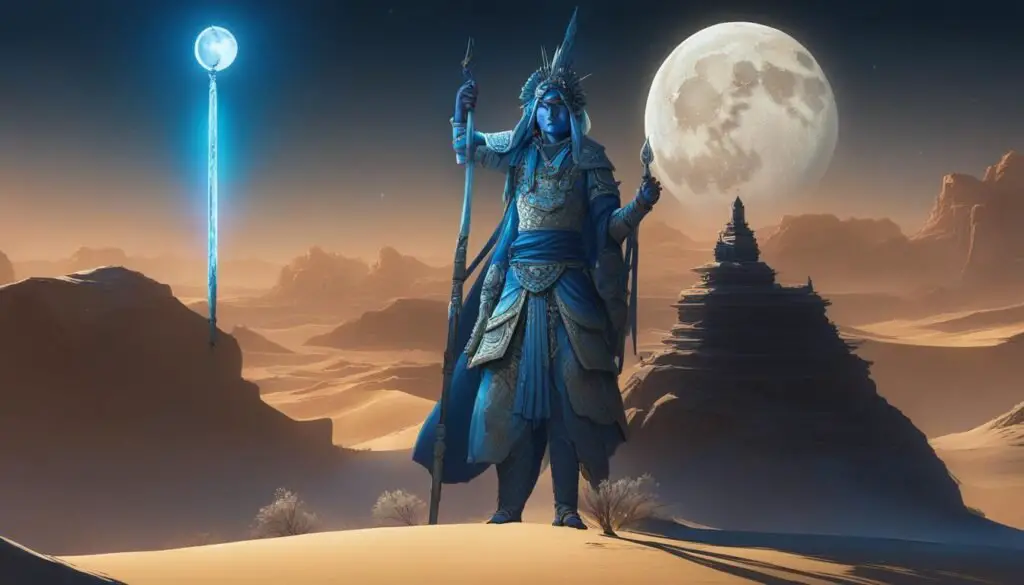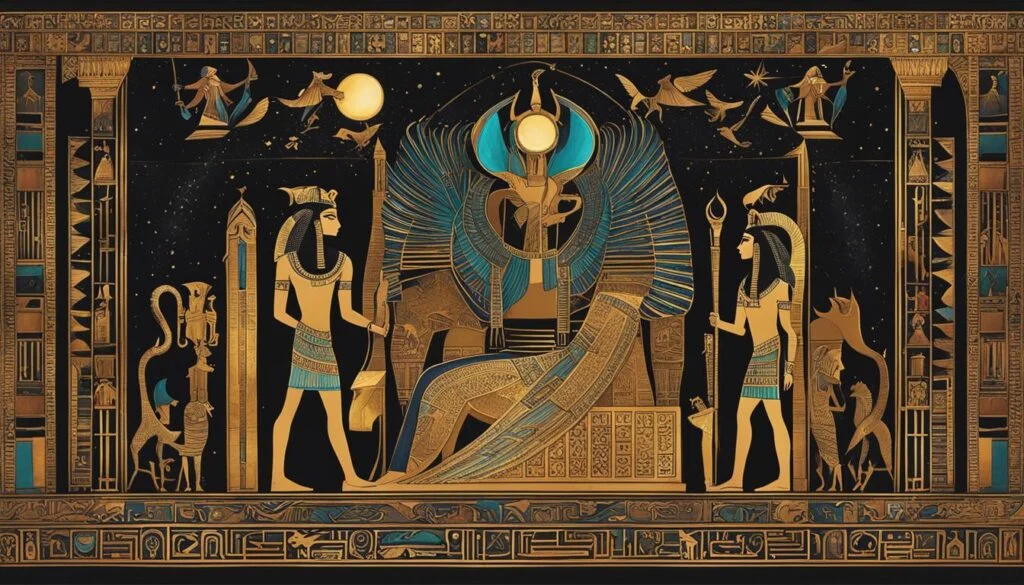Khonshu is an enigmatic deity in Egyptian mythology, revered as the god of the moon and known for his role as a protector in the night sky.
Khonshu, in ancient Egyptian religion, is the moon god associated with healing and protection, often depicted as a man with the head of a hawk, wearing a headdress adorned with a lunar disk. He was believed to influence fertility and the natural cycles, guiding and protecting travelers at night.
Key Takeaways:
- Khonshu is an ancient Egyptian god associated with the moon and known for his protective role.
- Khonshu’s mythology and symbolism are rooted in ancient Egyptian culture, with connections to fertility, magic, and the lunar cycle.
- The Egyptian god Khonshu is part of the Theban triad alongside Amon and Mut.
- Khonshu’s legacy extends beyond ancient Egypt, as he continues to influence popular culture and fascination with Egyptian mythology.
A Brief Introduction to Khonshu
Khonshu is a prominent god in ancient Egyptian mythology. Introduced in Marvel Comics in 1980,
Khonshu is now making his first live-action appearance in the Disney+ series “Moon Knight.”
This enigmatic deity plays a crucial role in the life of the series’ protagonist, Marc Spector, as he resurrects him and grants him enhanced abilities.
In this section, we will explore the origins and mythology surrounding Khonshu and delve into his significance in Egyptian culture.
In ancient Egyptian mythology, Khonshu is known as the god of the moon. He holds a prominent position in Egyptian society and is associated with various aspects, including fertility, healing, and lunar magic.
Khonshu’s presence in Marvel Comics and the “Moon Knight” series pays homage to his rich mythological background in Egyptian culture.
- Khonshu’s Origins: According to Egyptian mythology, Khonshu is believed to be the offspring of Amon and Mut, two powerful deities in the ancient Egyptian pantheon.
. - Mythological Significance: Khonshu’s connection to the moon represents the cycles of life, fertility, and magic in Egyptian culture. He symbolizes protection in the night sky.
. - Cultural Significance: Khonshu’s worship was widespread in ancient Egypt, and temples dedicated to him were built across the kingdom. He continues to captivate modern audiences through his portrayal in popular media.
As we delve deeper into the mythology and symbolism surrounding Khonshu, we will uncover the fascinating stories and beliefs that shaped this ancient Egyptian god’s enduring legacy.
Khonshu’s Iconography and Symbolism
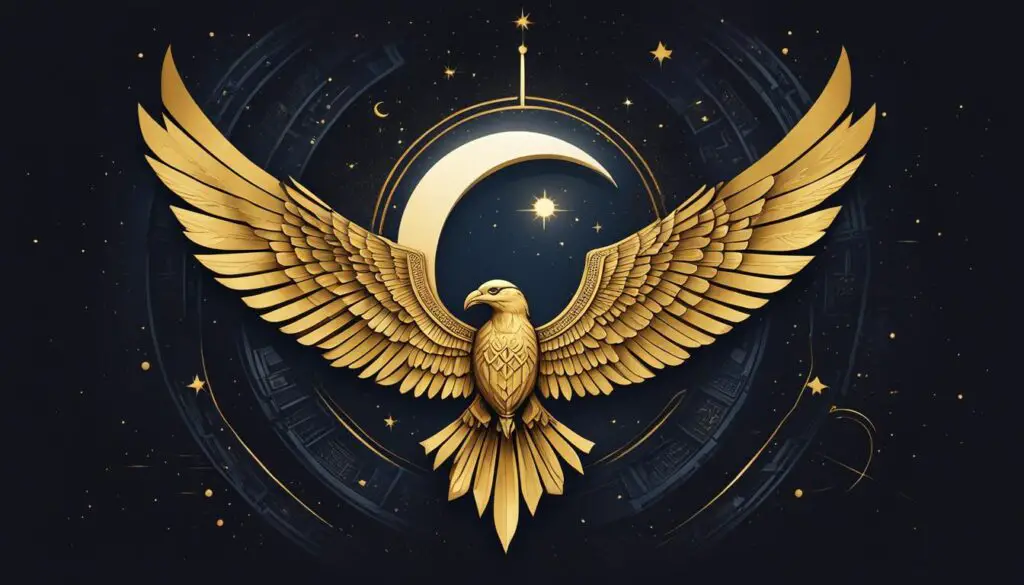
Khonshu, the ancient Egyptian deity, is commonly depicted in art with distinctive symbols that reflect his connection to the moon and his role as a protector.
These symbols hold deep meaning in the ancient Egyptian culture that revered him.
One of the most prominent features depicted in Khonshu’s iconography is his bird skull-like head.
This unique attribute symbolizes his association with death, rebirth, and the afterlife, as birds were often seen as messengers between the mortal world and the realm of the gods.
Another prominent symbol is Khonshu’s crescent moon-headed staff, which he is often shown holding.
This staff represents his dominion over the moon and its celestial power. The crescent moon, in ancient Egyptian culture, was associated with cycles, fertility, and magic.
Khonshu is also depicted wearing a flowing cape, symbolizing his role as a protective deity.
The cape represents his ability to shield and guide individuals through the darkness, much like the moon’s soothing light that illuminates the night.
In ancient Egyptian art, the symbolism associated with Khonshu’s iconography reflects the culture’s beliefs in the moon’s power, cycles, and protection.
The visual representations of Khonshu’s unique features and symbols served to honor and invoke his presence, emphasizing his significance as an ancient Egyptian deity.
Khonshu’s Role in Egyptian Mythology
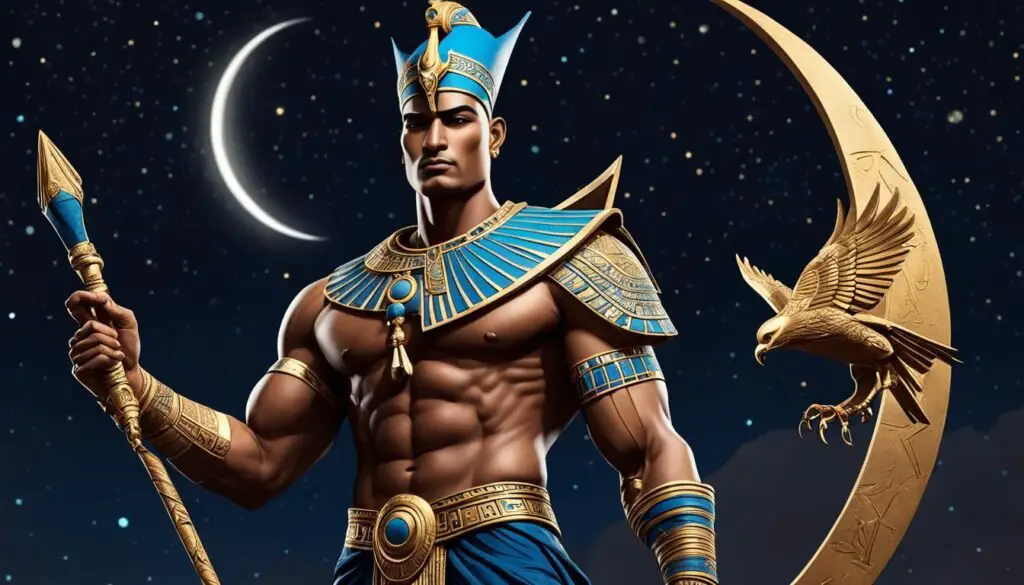
Khonshu plays a significant role in Egyptian mythology as the god of the moon. Believed to be the offspring of Amon and Mut, prominent deities in Egyptian pantheon, Khonshu holds associations with fertility, healing, and lunar magic.
Over time, Khonshu’s position evolved, eventually becoming a part of the Theban triad alongside Amon and Mut.
In Egyptian culture, Khonshu was revered for his powers and his ability to protect those who worshiped him.
This section will explore the mythology surrounding Khonshu and his relationships with other deities.
Khonshu’s role as the god of the moon reflects the importance of lunar cycles in ancient Egyptian society.
The moon was associated with fertility and the natural rhythms of life, making Khonshu a symbol of growth and rejuvenation.
As a healer, Khonshu was believed to possess the power to cure illnesses and provide spiritual guidance.
In addition to his healing abilities, Khonshu was revered for his lunar magic. Ancient Egyptians believed that the moon influenced their daily lives and rituals, and they looked to Khonshu as the deity who controlled these mystical forces.
Through his lunar magic, Khonshu offered protection and ensured the balance of the natural world.
The relationships between Khonshu and other Egyptian deities further emphasize his significance in the pantheon.
As a member of the Theban triad, Khonshu shared a close bond with Amon, the king of the gods, and Mut, the goddess of motherhood and protection.
This holy trinity represented the balance of power and protection in Egyptian mythology.
Khonshu’s role in Egyptian mythology showcases the deep connection between the moon and the spiritual realm.
As the god of the moon, he held immense influence over the lives of the ancient Egyptians, offering healing, protection, and a sense of harmony in the ever-changing natural world.
Khonshu’s Temple in Thebes

Among the numerous religious establishments in ancient Egypt, the temple dedicated to Khonshu in Thebes held immense significance.
Constructed during the reign of Ramesses III, this temple served as a focal point for the worship of Khonshu, the revered ancient Egyptian deity.
Its role extended beyond religious ceremonies, as it also acted as a gathering place for devotees and a center for various cultic activities.
Located in Thebes, the ancient city renowned for its rich religious and cultural heritage, Khonshu’s temple stood as a testament to the devotion and reverence towards this moon god.
Worshipers, including priests adorned in ceremonial attire, would convene within the grand halls of the temple, seeking solace, protection, and the blessings of Khonshu.
The architecture of the temple reflected the grandeur associated with deities in ancient Egyptian culture.
Elaborate carvings and intricate details adorned the walls, depicting scenes of devotion, celestial symbols, and representations of Khonshu himself.
The design and layout of the temple were carefully crafted to enhance the spiritual experience and create an atmosphere of reverence and awe.
Within these sacred walls, rituals, and ceremonies honoring Khonshu were performed by priests who channeled their unwavering faith into invoking the powers of the ancient Egyptian deity.
These rituals sought the protection and guidance of Khonshu, as well as the healing and miraculous assistance he was believed to offer to his devotees.
The temple in Thebes stood as a physical representation of the bond between the ancient Egyptians and Khonshu, providing a place where devotees could connect with their god and experience his divine presence.
It served as a powerful symbol of the enduring influence of Khonshu in ancient Egyptian society and continues to captivate us with its architectural splendor and rich cultural heritage.
Khonshu and Other Egyptian Deities
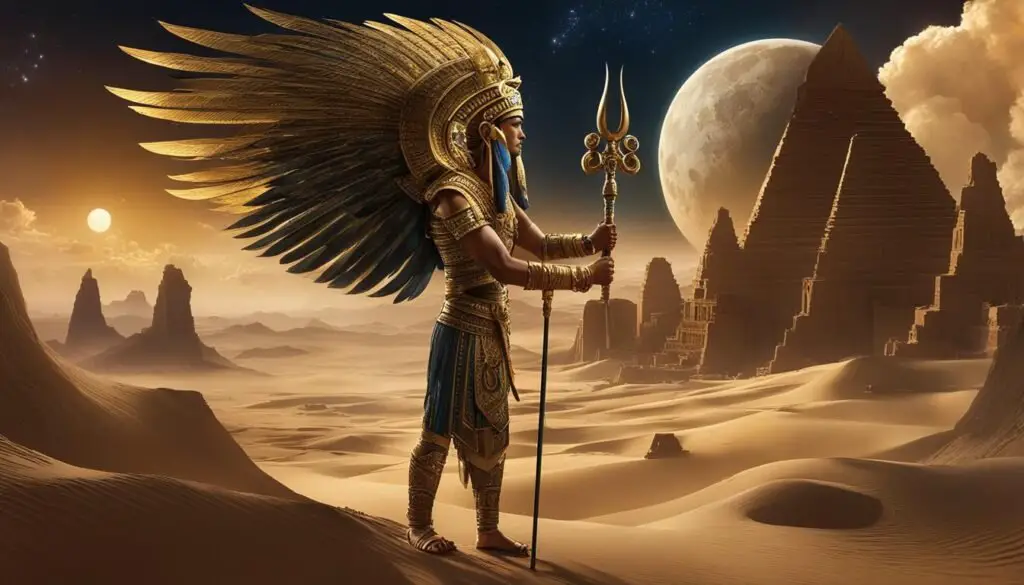
In Egyptian mythology, Khonshu, the ancient Egyptian deity, had significant interactions with various other gods and goddesses.
These divine relationships shed light on the intricate connections and shared associations between deities in ancient Egyptian culture.
One notable deity that Khonshu interacted with is Thoth, the god of wisdom and knowledge.
As the moon god, Khonshu’s connection to the cycles of the moon and the night sky resonated with Thoth’s domain of intellect and learning.
This association symbolized the harmonious balance between lunar symbolism and intellectual pursuits.
Khonshu was also closely associated with Ra, the sun god. While seemingly contrasting in their celestial domains, the relationship between Khonshu and Ra represented the interconnectedness of the celestial bodies and their respective influences on Egyptian life.
As the moon god, Khonshu’s emergence in the sky during the night mirrored Ra’s absence, creating a cyclical rhythm of light and darkness vital to Egyptian cosmology and mythology.
Additionally, Khonshu shared connections with various goddesses, including Hathor, Isis, and Selket.
These goddesses were associated with fertility, magic, and protection, attributes that resonated with Khonshu’s role as a protector and healer.
The shared themes of fertility and magical powers tied these deities together, reinforcing their collective significance in Egyptian culture and religious practices.
These interactions between Khonshu and other Egyptian deities exemplify the intricate tapestry of mythology within ancient Egyptian belief systems.
The coexistence and interplay of different gods and goddesses played a crucial role in shaping and understanding the complex religious and cultural landscape of ancient Egypt.
Key Relationships:
Key Relationships:
- ✅ Thoth – The god of wisdom and knowledge.
- ✅ Ra – The sun god.
- ✅ Hathor – The goddess of fertility and love.
- ✅ Isis – The goddess of magic and protection.
- ✅ Selket – The goddess associated with fertility and healing.
Khonshu’s Deeper Lore in Marvel’s “Moon Knight”

Marvel’s “Moon Knight” series on Disney+ presents a unique opportunity to explore the deeper lore and mythology of Khonshu.
In this show, Khonshu assumes a pivotal role as he bestows extraordinary powers upon the protagonist, Marc Spector.
Through the portrayal of Khonshu in “Moon Knight,” the existing mythology of the character is expanded upon, offering viewers new insights and interpretations into this enigmatic Egyptian god.
Khonshu’s Legacy and Influence
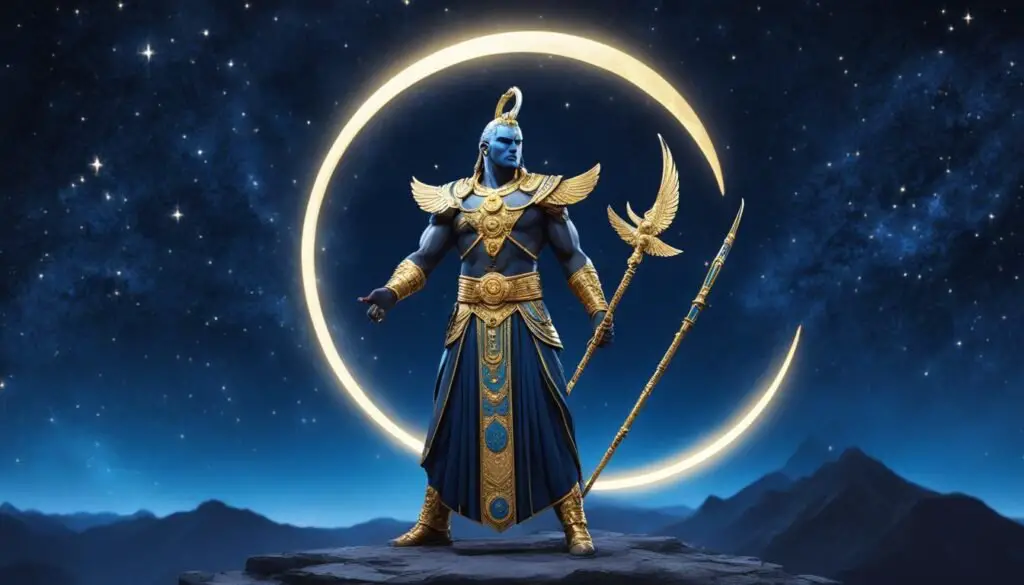
Khonshu, the enigmatic deity of Egyptian mythology, continues to leave a lasting impact beyond the realm of ancient culture.
His presence in Marvel Comics and now in the acclaimed “Moon Knight” series highlights the enduring influence of Egyptian gods in popular culture.
Today, Khonshu’s legacy resonates with audiences, captivating their imagination and fostering a deep fascination with Egyptian mythology.
Through the storytelling prowess of Marvel Comics, Khonshu has become an iconic character, inviting readers to explore the rich mythology surrounding him.
In the highly anticipated “Moon Knight” series, Khonshu’s portrayal showcases his continued significance and cultural relevance.
The enduring fascination with Egyptian mythology and its deities, like Khonshu, speaks to the timeless appeal of these ancient stories.
The mysterious realms of gods and goddesses, their epic tales, and symbolic meanings continue to capture our imagination and inspire artistic expressions across various mediums.
Khonshu’s Significance in “Moon Knight” Episode 3
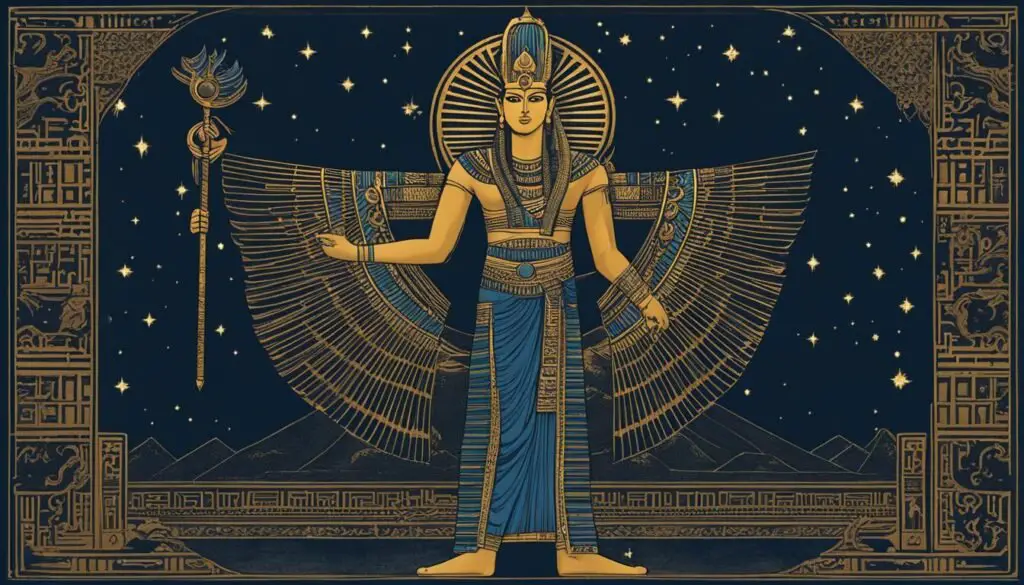
In episode 3 of “Moon Knight,” Khonshu unveils his power by assembling The Ennead, a group of Egyptian gods, to confront Arthur Harrow, a rival deity.
This episode provides an intriguing glimpse into the complex relationships between Khonshu and the other gods, shedding light on the deep mythology surrounding this enigmatic character.
As the god of the moon and protector of Marc Spector, Khonshu’s role in “Moon Knight” episode 3 holds immense significance.
One of the remarkable aspects of this episode is the exploration of Khonshu’s connection to Egyptian mythology.
As the viewers delve deeper into the narrative, they discover the intricate web of relationships between Khonshu and the other gods.
This insight not only adds depth to the character but also showcases the rich mythological tapestry that forms the backdrop of the story.
Confronting Arthur Harrow: A Clash of Gods
Khonshu’s decision to assemble The Ennead, a group of powerful Egyptian gods, signifies the gravity of the situation and amplifies the tension in the storyline.
By uniting these deities, Khonshu demonstrates his authority and the extent of his power.
This confrontation between gods not only showcases Khonshu’s strength but also highlights the intricate dynamics between the gods within the Egyptian pantheon.
Exploring the Deep Mythology
“Moon Knight” episode 3 provides an opportunity to delve into the fascinating mythology surrounding Khonshu.
It unravels the intricate tales and legends associated with this ancient Egyptian deity, shedding light on the deity’s role and significance in the larger narrative.
As viewers immerse themselves in the story, they gain a deeper understanding of Khonshu’s place in Egyptian mythology and the impact of his actions on the larger cosmic order.
As the mythology of “Moon Knight” continues to unfold, Khonshu’s role promises to captivate and intrigue fans, giving them a unique perspective on the ancient Egyptian god and his influence on the modern-day narrative.
Stay tuned as we continue to unravel the secrets and significance of Khonshu’s character in “Moon Knight” and explore the enduring fascination with Egyptian mythology.
Khonshu’s Cannibalistic Nature
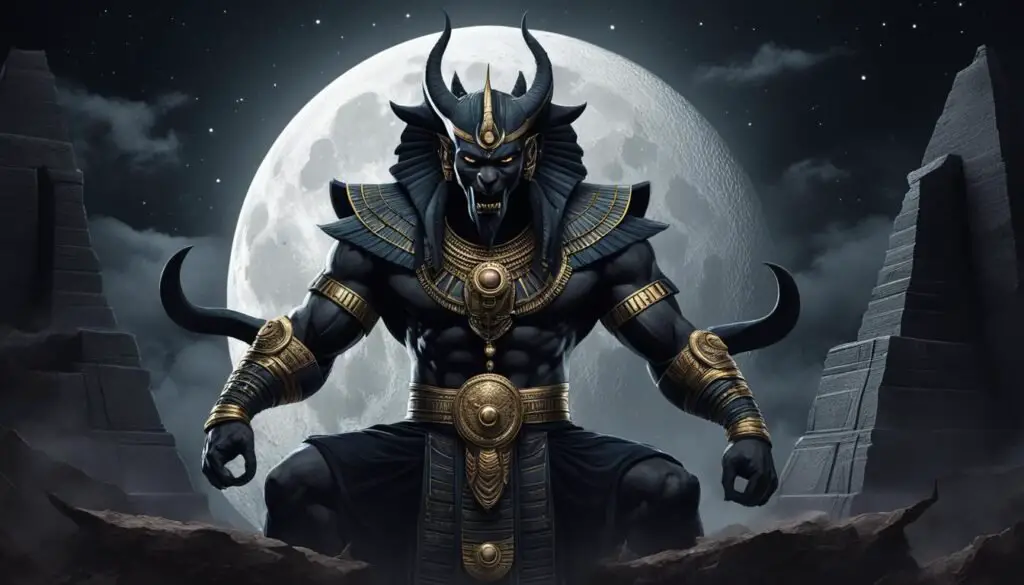
In Egyptian mythology, Khonshu is often depicted with a cannibalistic nature, where he devours other gods and goddesses.
This aspect of Khonshu’s character has sparked legends and interpretations, steeped in the rich symbolism of ancient Egyptian art.
Khonshu’s cannibalistic nature holds symbolic meaning within the context of Egyptian mythology.
It represents the perpetual cycle of life and death, with Khonshu consuming and absorbing the powers of other deities to further his own divine strength and influence.
This idea of cannibalism is also believed to embody the concept of divine transcendence, where Khonshu merges with the essence of the gods and goddesses he consumes, incorporating their attributes and knowledge into his being.
Ancient Egyptian art often portrays Khonshu’s cannibalistic nature through intricate hieroglyphics and detailed reliefs.
These artistic representations capture the intense and mythical nature of Khonshu’s devouring acts, depicting the god in fierce battles with other deities, consuming their essence to become even more powerful.
Embedded within these artistic depictions is a narrative of cosmic balance, where Khonshu’s cannibalism serves to maintain harmony within the Egyptian pantheon. By assimilating the powers of other deities, Khonshu ensures equilibrium and the continued flow of divine energy.
The symbolism of Khonshu’s cannibalistic nature highlights the intricate and complex nature of Egyptian mythology, showcasing the interplay between gods and goddesses as they shape the world and its cosmic order.
Worship of Khonshu in Ancient Egypt
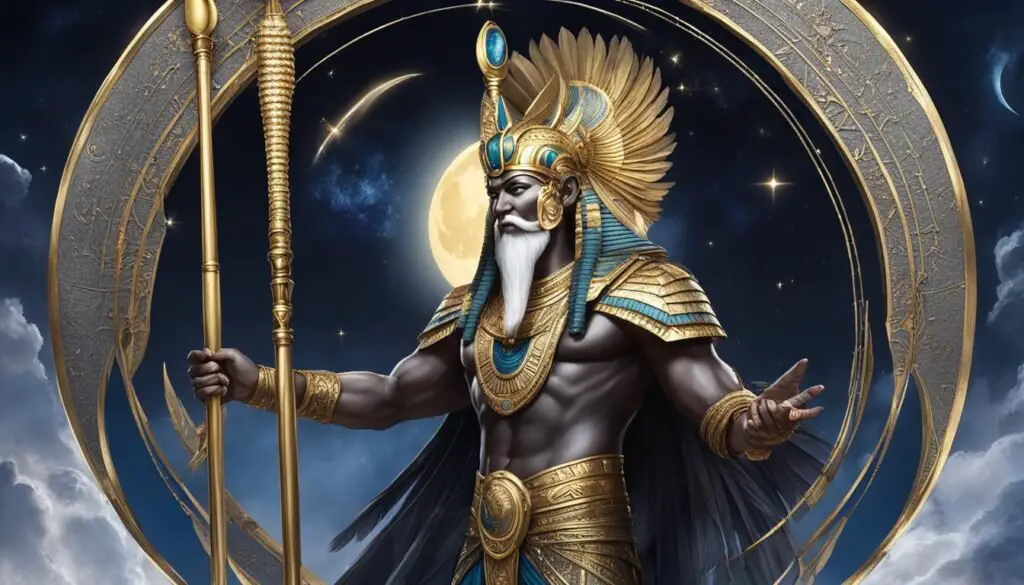
Khonshu, the enigmatic Egyptian moon god, held a revered position in ancient Egyptian society, with numerous temples dedicated to his worship throughout the kingdom.
The worship of Khonshu involved engaging in a range of rituals and practices to honor and seek his favor.
Followers of Khonshu offered various gifts and sacrifices as part of their devotion.
These offerings included food, flowers, and valuable items placed at the feet of Khonshu’s statues or altars within the temples.
Animal sacrifices, such as sheep and bulls, were also common, symbolizing the devotee’s willingness to give up something significant to gain the god’s favor.
Prayer played a vital role in the worship of Khonshu. Worshipers would gather in the temples, reciting prayers and hymns, seeking the god’s protection and blessings.
These prayers often emphasized Khonshu’s role as a guardian and healer, beseeching him to watch over the community’s well-being and to offer guidance and solace.
One of the most prominent temples dedicated to Khonshu’s worship was located in Thebes, an ancient Egyptian city.
This temple, built during the reign of Ramesses III, was a hub of cultic activity and served as a gathering place for devotees seeking Khonshu’s divine presence.
The temple’s architecture reflected the significance of Khonshu, with grand columns, intricate carvings, and statues depicting the god.
Personal devotion to Khonshu played an essential role in connecting individuals with the god’s power and protection.
It was common for people to have personal altars or shrines within their homes dedicated to Khonshu.
Here, they would offer prayers, light incense, and present offerings as a daily act of reverence.
Khonshu, with his association with the moon and his role as a protector, held a significant place in the hearts and minds of ancient Egyptians.
His worship provided a profound connection to the celestial realm and an avenue for seeking guidance, healing, and divine intervention.
Conclusion
Khonshu, the Egyptian moon god, holds a fascinating place in both ancient Egyptian mythology and popular culture.
Revered as the god of the moon, Khonshu is known for his enigmatic character and his role as a protector in the night sky.
From his origins and associations in Egyptian religion to his portrayal in Marvel’s “Moon Knight,” Khonshu embodies the mystique and power of the moon.
Throughout this article, we have explored the various aspects of Khonshu’s lore and the significance of his character, shedding light on this ancient Egyptian deity.
In ancient Egyptian mythology, Khonshu was believed to be the offspring of Amon and Mut, two prominent deities.
He held a pivotal role as the god of the moon, associated with fertility, healing, and lunar magic.
Over time, Khonshu’s position in the Egyptian pantheon evolved, becoming a part of the Theban triad alongside Amon and Mut.
His visual representation with a bird skull-like head, crescent moon-headed staff, and flowing cape reflected his connection to the moon and his role as a protector.
In recent years, Khonshu has gained renewed attention through his appearance in the Disney+ series “Moon Knight.”
As the patron deity of the protagonist, Marc Spector, Khonshu grants him enhanced abilities and plays a pivotal role in his journey as a superhero.
This modern portrayal further showcases the enduring influence of Egyptian gods in popular culture, captivating audiences with the fusion of ancient mythology and modern storytelling.
From his rich mythology in ancient Egypt to his presence in contemporary media, Khonshu remains an intriguing figure.
Whether one seeks to understand the deep roots of Egyptian mythology or explores the captivating storylines of “Moon Knight,” Khonshu’s character holds a timeless allure, forever tied to the captivating mystique and power of the moon.
FAQ
Who is Khonshu in Egyptian mythology?
Khonshu is a prominent deity in Egyptian mythology, revered as the god of the moon and known for his role as a protector in the night sky.
What is the mythology surrounding Khonshu?
Khonshu is believed to be the offspring of Amon and Mut, two prominent Egyptian deities. He is associated with fertility, healing, and lunar magic.
What is the significance of Khonshu’s iconography?
Khonshu is often depicted as a figure with a bird skull-like head, holding a crescent moon-headed staff, and wearing a flowing cape. These symbols represent his connection to the moon and his role as a protector.
What role did Khonshu play in Egyptian mythology?
Khonshu is the god of the moon and is associated with fertility, healing, and lunar magic. Over time, he became a part of the Theban triad alongside Amon and Mut.
What was the significance of Khonshu’s temple in Thebes?
Khonshu’s temple in Thebes was a significant religious establishment dedicated to his worship. It served as a center of cultic activity, where rituals and ceremonies were conducted to seek Khonshu’s protection and invoke his healing powers.
How did Khonshu interact with other Egyptian deities?
Khonshu had relationships with various other deities, including Thoth, Ra, Hathor, Isis, and Selket. These interactions were based on shared connections to fertility, magic, and other aspects of Egyptian mythology.
What is Khonshu’s role in Marvel’s “Moon Knight”?
In Marvel’s “Moon Knight,” Khonshu grants powers to the protagonist, Marc Spector. He plays a pivotal role as the source of Moon Knight’s abilities.
What is the cultural significance of Khonshu today?
Khonshu’s depiction in Marvel Comics and the “Moon Knight” series highlights the enduring influence of Egyptian gods in popular culture. It continues to fascinate people and keep Egyptian mythology alive.
What is the significance of Khonshu’s role in “Moon Knight” episode 3?
In episode 3 of “Moon Knight,” Khonshu assembles The Ennead, a group of Egyptian gods, to confront a rival deity. This episode explores Khonshu’s connections to other gods and deepens the character’s mythology.
What is the legend surrounding Khonshu’s cannibalistic nature?
In Egyptian mythology, there are tales of Khonshu’s cannibalistic nature, where he devours other gods and goddesses. This has symbolic meaning and is portrayed in ancient Egyptian art.
How was Khonshu worshiped in ancient Egypt?
Khonshu was widely worshiped in ancient Egypt, with temples dedicated to his worship across the kingdom. Worshipers conducted rituals and ceremonies, offering prayers and even animal sacrifices to seek Khonshu’s favor.
What is the significance of Khonshu in Egyptian mythology?
Khonshu holds a significant role as the god of the moon and is associated with fertility, healing, and lunar magic in Egyptian mythology.


